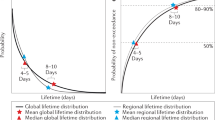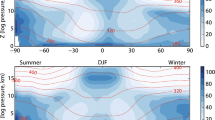Abstract
Water vapour modulates energy flows in Earth's climate system through transfer of latent heat by evaporation and condensation and by modifying the flows of radiative energy both in the longwave and shortwave portions of the electromagnetic spectrum. This article summarizes the role of water vapour in Earth's energy flows with particular emphasis on (1) the powerful thermodynamic constraint of the Clausius Clapeyron equation, (2) dynamical controls on humidity above the boundary layer (or free-troposphere), (3) uncertainty in continuum absorption in the relatively transparent "window" regions of the radiative spectrum and (4) implications for changes in the atmospheric hydrological cycle.

Similar content being viewed by others
Notes
Latent heat released by condensation is retained in the atmosphere only after the water is removed by precipitation to the surface before re-evaporation in the atmosphere can occur.
The first term is larger than the second term by a factor \(q_{\rm s}p/\epsilon e_{\rm s}=p/(p-e_{\rm s}(1-\epsilon))=1+q_{\rm s}((1/\epsilon)-1) \sim 1+0.6q_s\) assuming fixed pressure, where ε = 0.622 is the ratio of gas constants for dry air and water vapour. For a surface pressure of 1,000 hPa and using the August−Roche–Magnus empirical approximation for e s(T), the first term exceeds the second term by around 0.2% at 273 K and by 1% at 300 K.
References
Allan RP (2009) Examination of relationships between clear-sky longwave radiation and aspects of the atmospheric hydrological cycle in climate models, reanalyses, and observations. J Climate 22:3127–4145
Allan RP (2011) Human influence on rainfall. Nature 470:344–345
Allan RP, Shine KP, Slingo A, Pamment JA (1999) The dependence of clear-sky outgoing longwave radiation on surface temperature and relative humidity. Q J R Meteorol Soc 125:2103–2126
Allan RP, Soden BJ, John VO, Ingram W, Good P (2010) Current changes in tropical precipitation. Environ Res Lett 5. doi:10.1088/1748-9326/5/2/025205
Andrews T, Forster PM, Boucher O, Bellouin N, Jones A (2010) Precipitation, radiative forcing and global temperature change. Geophys Res Lett 37:L14701. doi:10.1029/2010GL043991
Bengtsson L, Hodges KI, Keenlyside N (2009) Will extra-tropical storms intensify in a warmer climate? J Climate 22:2276–2301
Brogniez H, Roca R, Picon L (2005) Evaluation of the distribution of subtropical free tropospheric humidity in AMIP-2 simulations using METEOSAT water vapor channel data. Geophys Res Lett 32:L19708
Chou C, Chen C (2010) Depth of convection and the weakening of tropical circulation in global warming. J Climate 23:3019–3030
Chou C, Tu J, Tan P (2007) Asymmetry of tropical precipitation change under global warming. Geophys Res Lett 34:L17708. doi:10.1029/2007GL030327
Folkins I, Kelly KK, Weinstock EM (2002) A simple explanation of the increase in relative humidity between 11 and 14 km in the tropics. J Geophys Res 107:4736. doi:10.1029/2002JD002185
Galewsky J, Sobel A, Held I (2005) Diagnosis of subtropical humidity dynamics using tracers of last saturation. J Atmos Sci 62:3353–3367
Gastineau G, Soden BJ (2011) Evidence for a weakening of tropical surface wind extremes in response to atmospheric warming. Geophys Res Lett 38:L09706. doi:10.1029/2011GL047138
Gimeno L, Drumond A, Nieto R, Trigo RM, Stohl A (2010) On the origin of continental precipitation. Geophys Res Lett 37:L13804
Haerter JO, Berg P, Hagemann S (2010) Heavy rain intensity distributions on varying time scales and at different temperatures. J Geophys Res 115:D17102
Hardwick-Jones R, Westra S, Sharma A (2010) Observed relationships between extreme sub-daily precipitation, surface temperature, and relative humidity. Geophys Res Lett 37:L22805
Held IM, Soden BJ (2006) Robust responses of the hydrological cycle to global warming. J Climate 19:5686–5699
John VO, Soden BJ (2006) Does convectively-detrained cloud ice enhance water vapor feedback? Geophys Res Lett 33:L20701
John VO, Soden BJ (2007) Temperature and humidity biases in global climate models and their impact on climate feedbacks. Geophys Res Lett 34:L18704. doi:10.1029/2007GL030429
Knutson TR, Manabe S (1995) Time-mean response over the tropical Pacific to increased CO2 in a coupled ocean-atmosphere model. J Climate 8:2181–2199
Lambert FH, Chiang JCH (2007) Control of land-ocean temperature contrast by ocean heat uptake. Geophys Res Lett 34:L13704
Lambert FH, Webb MJ (2008) Dependency of global mean precipitation on surface temperature. Geophys Res Lett 35:L16706. doi:10.1029/2008GL034838
Lenderink G, van Meijgaard E (2010) Linking increases in hourly precipitation extremes to atmospheric temperature and moisture changes. Environ Res Lett 5:025208
Levermann A, Schewe J, Petoukhov V, Held H (2009) Basic mechanism for abrupt monsoon transitions. Proc Nat Acad Sci 106:20,572–20,577
Minschwaner K, Dessler AE (2004) Water vapor feedback in the tropical upper troposphere: model results and observations. J Climate 17:1272–1282
Mitchell J, Wilson CA, Cunnington WM (1987) On CO2 climate sensitivity and model dependence of results. Q J R Meteorol Soc 113:293–322
Muller CJ, O’Gorman PA (2011) An energetic perspective on the regional response of precipitation to climate change. Nat Climate Change 1:266–271
O’Gorman PA, Muller CJ (2010) How closely do changes in surface and column water vapor follow Clausius-Clapeyron scaling in climate change simulations. Environ Res Lett 5:025207. doi:10.1088/1748-9326/5/2/025207
O’Gorman PA, Schneider T (2009) The physical basis for increases in precipitation extremes in simulations of 21st-century climate change. Proc Nat Acad Sci 106:14,773–14,777
O’Gorman PA, Allan RP, Byrne MP, Previdi M (2012) Energetic constraints on precipitation under climate change. Surv Geophys. doi:10.1007/s10712-011-9159-6
Pierrehumbert RT (1998) Lateral mixing as a source of subtropical water vapor. Geophys Res Lett 25:151–154
Power SB, Kociuba G (2011) What caused the observed 20th century weakening of the Walker circulation? J Climate (in press). doi:10.1175/2011JCLI4101.1
Previdi M (2010) Radiative feedbacks on global precipitation. Environ Res Lett 5:025–211
Raval A, Ramanathan V (1989) Observational determination of the greenhouse effect. Nature 342:758–761
Richter I, Xie SP (2008) The muted precipitation increase in global warming simulations: a surface evaporation perspective. J Geophys Res 113:D24118. doi:10.1029/2008JD010561
Roca R, Guzman R, Lemond J, Meijer J, Picon L, Brogniez H (2012) Tropical and extra-tropical influences on the distribution of free tropospheric humidity over the intertropical belt. Surv Geophys (this volume)
Semenov V, Bengtsson L (2002) Secular trends in daily precipitation characteristics: greenhouse gas simulation with a coupled AOGCM. Climate Dyn 19:123–140
Sherwood SC, Ingram W, Tsushima Y, Satoh M, Roberts M, Vidale PL, O’Gorman PA (2010a) Relative humidity changes in a warmer climate. J Geophys Res 115:D09104. doi:10.1029/2009JD012585
Sherwood SC, Roca R, Weckwerth TM, Andronova NG (2010b) Tropospheric water vapor, convection, and climate. Rev Geophys 48:RG2001
Shine KP, Ptashnik IV, Rädel G (2012) The water vapour continuum: brief history and recent developments. Surv Geophys (this volume)
Simmons AJ, Willett KM, Jones PD, Thorne PW, Dee DP (2010) Low-frequency variations in surface atmospheric humidity, temperature, and precipitation: inferences from reanalyses and monthly gridded observational data sets. J Geophys Res 115:D01110. doi:10.1029/2009JD012442
Soden BJ, Held IM (2006) An assessment of climate feedbacks in coupled ocean-atmosphere models. J Climate 19:3354–3360
Soden BJ, Vecchi G (2011) The vertical distribution of cloud feedback in coupled ocean-atmosphere models. Geophys Res Lett 38:L12704. doi:10.1029/2011GL047632
Sohn BJ, Park SC (2010) Strengthened tropical circulations in past three decades inferred from water vapor transport. J Geophys Res 115:D15112. doi:10.1029/2009JD013713
Solomon S, Rosenlof KH, Portmann RW, Daniel JS, Davis SM, Sanford TJ, Plattner GK (2010) Contributions of stratospheric water vapor to decadal changes in the rate of global warming. Science 327:1219–1223
Spencer RW, Braswell WD (1997) How dry is the tropical free troposphere? Implications for global warming theory. Bull Am Meterol Soc 78:1097–1106
Stephens GL, Ellis TD (2008) Controls of global-mean precipitation increases in global warming GCM experiments. J Climate 21:6141–6155
Sugiyama M, Shiogama H, Emori S (2010) Precipitation extreme changes exceeding moisture content increases in MIROC and IPCC climate models. Proc Nat Acad Sci 107:571–575
Takahashi K (2009) The global hydrological cycle and atmospheric shortwave absorption in climate models under CO2 forcing. J Climate 22:5667–5675
Trenberth KE (2002) Changes in tropical clouds and radiation. Science 296:2095a
Trenberth KE (2011) Changes in precipitation with climate change. Climate Res 47:123–138
Vecchi GA, Soden BJ, Wittenberg AT, Held IM, Leetmaa A, Harrison MJ (2006) Weakening of tropical pacific atmospheric circulation due to anthropogenic forcing. Nature 441:73–76
Wentz FJ, Ricciardulli L, Hilburn K, Mears C (2007) How much more rain will global warming bring? Science 317:233–235
Zahn M, Allan RP (2011) Changes in water vapor transports of the ascending branch of the tropical circulation. J Geophys Res 116:D18111. doi:10.1029/2011JD016206
Zelinka MD, Hartmann DL (2010) Why is longwave cloud feedback positive? J Geophys Res 115:D16117
Acknowledgments
Thanks to Paul O’Gorman, Remy Roca, Keith Shine, Brian Soden and two anonymous reviewers for comments and corrections on the original manuscript and for their input, along with B.-J. Sohn, Andrew Dessler and many others, to the International Space Sciences Institute Workshop Session on Observing and modelling Earth’s energy flows. R Allan was supported by the UK Natural Environment Research Council PREPARE project (NE/G015708/1).
Author information
Authors and Affiliations
Corresponding author
Rights and permissions
About this article
Cite this article
Allan, R.P. The Role of Water Vapour in Earth’s Energy Flows. Surv Geophys 33, 557–564 (2012). https://doi.org/10.1007/s10712-011-9157-8
Received:
Accepted:
Published:
Issue Date:
DOI: https://doi.org/10.1007/s10712-011-9157-8




